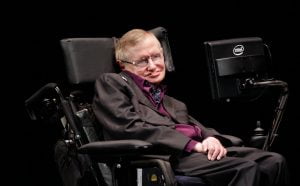 So, to know this genius’ background lets delve deeper into his past:
So, to know this genius’ background lets delve deeper into his past:Who is Stephen Hawking?
Stephen Hawking (born January 8, 1942) is a British scientist, professor and author who has done groundbreaking work in physics and cosmology, and whose books have helped to make science accessible to everyone. At age 21, while studying cosmology at the University of Cambridge, he was diagnosed with amyotrophic lateral sclerosis (ALS) due to which he got his entire body paralyzed for the rest of his life.
Over the years, Stephen Hawking has written or co-written a total of 15 books. A few of the most noteworthy include:
‘A Brief History of Time’
In 1988 Hawking rose to international fame with the publication of A Brief History of Time. The short, informative book became an account of cosmology for the masses and offered an overview of space and time, the existence of God and the future.
The book was an instant hit and remained more than four years atop the London Sunday Times’ best-seller list. Since its release, it has sold millions of copies worldwide and been translated into more than 40 languages.
‘The Universe in a Nutshell’
A Brief History of Time also wasn’t as easy to understand as some had hoped. So in 2001, Hawking followed up his book with The Universe in a Nutshell, which offered a more illustrated and basic tour to cosmology’s big theories.
‘A Briefer History of Time’
In 2005, Hawking authored the even more accessible A Briefer History of Time, which further simplified the original work’s core concepts and touched upon the newest developments in the field of string theory.

These 3 books along with Hawking’s own research and papers, lead the physicist’s personal search for science’s Holy Grail: a single unifying theory that can combine cosmology (the study of the big) with quantum mechanics (the study of the small) to explain how the universe began.
It’s this kind of ambitious thinking that has allowed Hawking, who claims he can think in 11 dimensions, to lay out some big possibilities for humankind.
He’s convinced that time travel is possible, and that humans may indeed colonize other planets in the future.
‘The Grand Design’
It was in September 2010, when Hawking broke the world into two polarized opinions about him by speaking against the idea that God could have created the universe in his book The Grand Design.
Hawking previously had also argued that belief in a creator could be compatible with modern scientific theories.
His new work, however, concluded that the Big Bang was the inevitable consequence of the laws of physics and nothing more.
Because there is a law such as gravity, the universe can and will create itself from nothing.
-said Hawking
Spontaneous creation is the reason there is something rather than nothing, why the universe exists, why we exist.
And one more important point in this work was that Hawking set out to challenge Sir Isaac Newton’s belief that the universe had to have been designed by God, simply because it could not have been born from chaos.
It is not necessary to invoke God to light the blue touch paper and set the universe going.
-Hawking said.
What About The Disease That Stephen Hawking Have?

At the age of 21, Stephen Hawking was diagnosed with amyotrophic lateral sclerosis (ALS). Precisely it means that the nerves that controlled his muscles were shutting down.
I was told that I could only love for two or less years. But I knew I could defy this convention too. My brain was strong enough.
Hawking first began to notice problems with his physical health while he was at Oxford—on occasion he would trip and fall, or slur his speech—he didn’t look into the problem until 1963, during his first year at Cambridge.
For the most part, Hawking had kept these symptoms to himself. But when his father took notice of the condition, he took Hawking to see a doctor. For the next two weeks, the 21-year-old college student made his home at a medical clinic, where he underwent a series of tests.
They took a muscle sample from my arm, stuck electrodes into me, and injected some radio-opaque fluid into my spine, and watched it going up and down with X-rays, as they tilted the bed.
-he once said.
After all that, they didn’t tell me what I had, except that it was not multiple sclerosis, and that I was an atypical case.
Eventually, however, doctors did diagnose Hawking with the early stages of ALS. The news was devastating for him and his family, but a few events prevented him from becoming completely despondent.

The first of these came while Hawking was still in the hospital. There, he shared a room with a boy suffering from leukaemia. Relative to what his roommate was going through, Hawking later reflected, his situation seemed more tolerable.
The second incident came when Hawking had a dream that he was going to be executed. He said this dream made him realize that there were still things to do with his life.
In a sense, Hawking’s disease helped him become the noted scientist he is today.
Before my condition was diagnosed, I had been very bored with life.
-he said.
There had not seemed to be anything worth doing.
By the mid-1970s, the Hawking family had taken in one of Hawking’s graduate students to help manage his care and work. He could still feed himself and get out of bed, but virtually everything else required assistance. In addition, his speech had become increasingly blurred, so that only those who knew him well could understand him. In 1985 he lost his voice for good following a tracheotomy.
What now?

It also put in peril Hawking’s ability to do his work. The predicament caught the attention of a California computer programmer, who had developed a speaking program that could be directed by the head or eye movement.
This invention helped Hawking to select words on a computer screen that were then passed through a speech synthesizer.
At the time of its introduction, Hawking, who still had use of his fingers, selected his words with a handheld clicker. Today, with virtually all control of his body gone, Hawking directs the program through a cheek muscle attached to a sensor.
Through the program, and the help of assistants, Stephen Hawking has continued to write at a prolific rate. His work has included numerous scientific papers, of course, but also information for the non-scientific community.
In October 2017, when the Cambridge University posted Hawking’s 1965 doctoral thesis, “Properties of Expanding Universes,” to its website. , it broke the internet by registering a staggering 60,000 views before the end of its first-day run.
On a note of update, it is recently announced that he was expected to make a full recovery.









